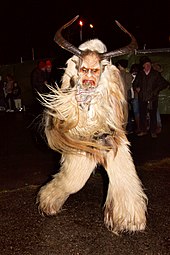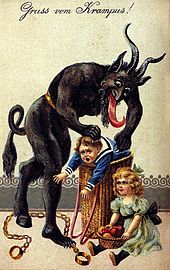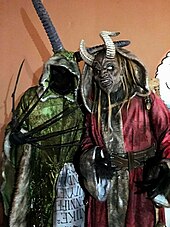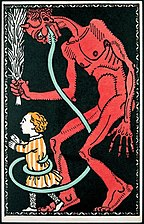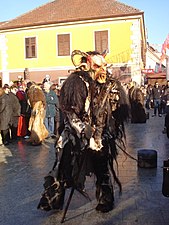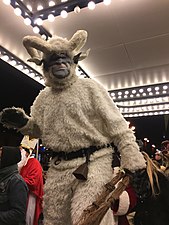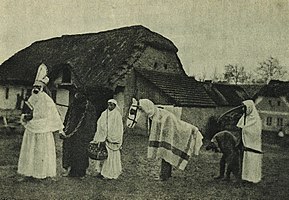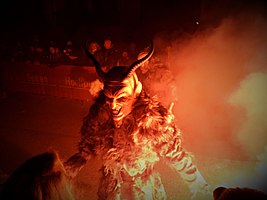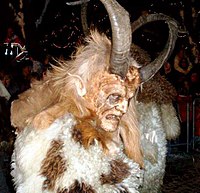
The bogeyman is a mythical creature typically used to frighten children into good behavior. Bogeymen have no specific appearances, and conceptions vary drastically by household and culture, but they are most commonly depicted as masculine or androgynous monsters that punish children for misbehavior. The bogeyman, and conceptually similar monsters can be found in many cultures around the world. Bogeymen may target a specific act or general misbehaviour, depending on the purpose of invoking the figure, often on the basis of a warning from an authority figure to a child. The term is sometimes used as a non-specific personification of, or metonym for, terror – and sometimes the Devil.

Sinterklaas or Sint-Nicolaas is a legendary figure based on Saint Nicholas, patron saint of children. Other Dutch names for the figure include De Sint, De Goede Sint and De Goedheiligman. Many descendants and cognates of "Sinterklaas" or "Saint Nicholas" in other languages are also used in the Low Countries, nearby regions, and former Dutch colonies.
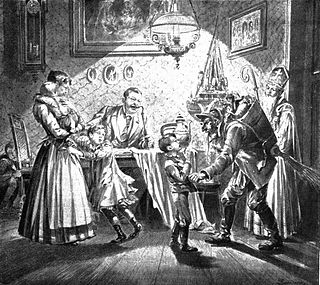
The companions of Saint Nicholas are a group of closely related figures who accompany Saint Nicholas throughout the territories formerly in the Holy Roman Empire or the countries that it influenced culturally. These characters act as a foil to the benevolent Christmas gift-bringer, threatening to thrash or abduct disobedient children. Jacob Grimm associated this character with the pre-Christian house spirit which could be benevolent or malicious, but whose mischievous side was emphasized after Christianization. The association of the Christmas gift-bringer with elves has parallels in English and Scandinavian folklore, and is ultimately and remotely connected to the Christmas elf in modern American folklore.

Saint Nicholas Day, also called the Feast of Saint Nicholas, observed on 6 December in Western Christian countries, and on 19 December in Eastern Christian countries using the old church Calendar, is the feast day of Saint Nicholas of Myra; it falls within the season of Advent. It is celebrated as a Christian festival with particular regard to Saint Nicholas' reputation as a bringer of gifts, as well as through the attendance of church services.
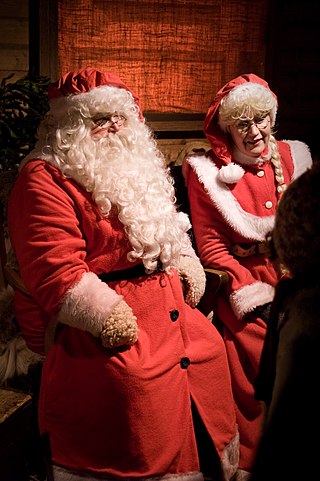
Joulupukki is a Finnish Christmas figure. The name joulupukki literally means 'Christmas goat' or 'Yule goat' in Finnish; the word pukki comes from the Germanic root bock, a cognate of English "buck", meaning 'billy-goat'. An old Nordic folk tradition, the figure is now often conflated with Santa Claus.
The central and eastern Alps of Europe are rich in folklore traditions dating back to pre-Christian times, with surviving elements originating from Germanic, Gaulish (Gallo-Roman), Slavic (Carantanian) and Raetian culture.

Swiss folklore describes a collection of local stories, celebrations, and customs of the alpine and sub-alpine peoples that occupy Switzerland. The country of Switzerland is made up of several distinct cultures including German, French, Italian, as well as the Romansh speaking population of Graubünden. Each group has its own unique folkloric tradition.

Ded Moroz, or Morozko, is a legendary figure similar to Saint Nicholas, Father Christmas, and Santa Claus who has his roots in Slavic mythology. The tradition of Ded Moroz is mostly spread in East Slavic countries and is a significant part of Russian culture. At the beginning of the Soviet era, communist authorities banned Ded Moroz. However, the ban was lifted and he soon became a significant part of Soviet culture. The literal translation of DedMoroz is Old Man Frost, but traditionally the name is translated as Father Frost.
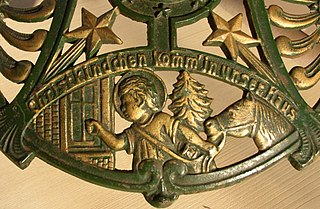
The Christkind, also called Christkindl, is the traditional Christmas gift-bringer in Austria, Switzerland, southern and western Germany, the Czech Republic, Croatia, Liechtenstein, Luxembourg, the eastern part of Belgium, Portugal, Slovakia, Hungary, parts of northeastern France, Upper Silesia in Poland, parts of Latin America, in certain areas of southern Brazil, and in the Acadiana region of Louisiana. Christkind is called in Portuguese Menino Jesus, in Hungarian Jézuska, in Slovak Ježiško, in Czech Ježíšek, in Latin America Niño Dios or Niño Jesús and in Croatian Isusić or Isusek, in Silesian Dziyciōntko Jezus, in Cieszyn Silesian Aniołek, in Polish Dzieciątko. In some parts of Italy, the analogous figure of the Christkind is known as Gesù Bambino.
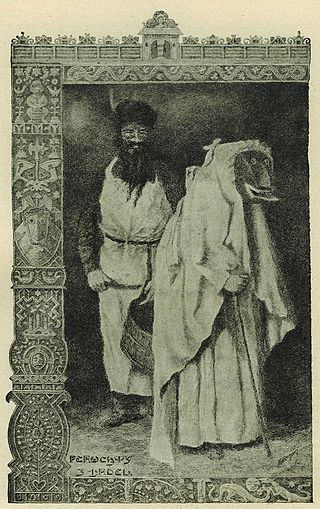
Perchta or Berchta ('Bertha'), also commonly known as Percht and other variations, was once known as a goddess in Alpine paganism in the Upper German and also Austrian and Slovenian regions of the Alps. Her name may mean 'the bright one' and is probably related to the name Berchtentag, meaning 'the feast of the Epiphany'. Eugen Mogk provides an alternative etymology, attributing the origin of the name Perchta to the Old High German verb pergan, meaning 'hidden' or 'covered'. The exact origin or time of origin is unknown.
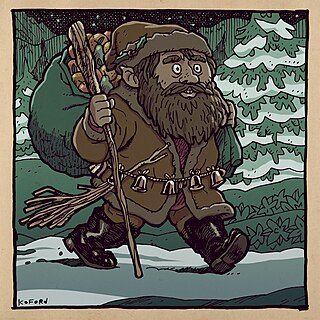
Knecht Ruprecht is a companion of Saint Nicholas as described in the folklore of Germany. He is the most popular gift-bringing character in Germany after Saint Nicholas, Christkindl, and Der Weihnachtsmann but is virtually unknown outside the country. He first appears in written sources in the 17th century, as a figure in a Nuremberg Christmas procession.

The Yule goat is a Scandinavian and Northern European Yule and Christmas symbol and tradition. Its origin is from Germanic paganism and has existed in many variants during Scandinavian history. Modern representations of the Yule goat are typically made of straw.

Belsnickel is a crotchety, fur-clad Christmas gift-bringer figure in the folklore of the Palatinate region of southwestern Germany along the Rhine, the Saarland, and the Odenwald area of Baden-Württemberg. The figure is also preserved in Pennsylvania Dutch communities and Brazilian-German communities.

Santa Claus is a legendary figure originating in Western Christian culture who is said to bring gifts during the late evening and overnight hours on Christmas Eve. He is said to accomplish this with the aid of Christmas elves, who make the toys in his workshop, and with the aid of flying reindeer who pull his sleigh through the air.

Père Fouettard is a character who accompanies Saint Nicholas on his rounds during Saint Nicholas Day dispensing lumps of coal and/or beatings to naughty children while St. Nicholas gives gifts to the well behaved. He is known mainly in the far north and eastern regions of France, in the south of Belgium, and in French-speaking Switzerland, although similar characters exist all over Europe. This "Happy Father" was said to bring a whip with him to spank all of the naughty children who misbehaved.

Saint Nicholas is a legendary figure in European folklore based on the Greek early Christian bishop Nicholas of Myra, patron saint of children.

The Sack Man is a figure similar to the bogeyman, portrayed as a man with a sack on his back who carries naughty children away.

A number of Midwinter or Christmas traditions in European folklore involve gift-bringers. Mostly involving the figure of a bearded old man, the traditions have mutually influenced one another, and have adopted aspects from Christian hagiography, even before the modern period. In Eastern Slavic countries, the figure is Father Frost. In Scandinavia, it is an elf-like figure or tomten who comes at Yule. In German-speaking Europe and Latin Europe, it became associated with the Christian Saint Nicholas. In some parts of Central Europe, there is a separate tradition of a young child or fairy-like being bringing presents, known as Christkind. Early modern England had Father Christmas, a character initially associated with feasting and good cheer, though he was not originally a gift bringer.

Krampus is a 2015 Christmas comedy horror film based on the eponymous character from Austro-Bavarian folklore, directed by Michael Dougherty, who co-wrote with Todd Casey and Zach Shields. The film stars Adam Scott, Toni Collette, David Koechner, Allison Tolman, Conchata Ferrell, Emjay Anthony, Stefania LaVie Owen, with Krista Stadler, and introducing Lolo Owen, Queenie Samuel, Maverick Flack, and Sage Hunefeld. In the film, a dysfunctional family squabbling causes a young boy (Max) to lose his festive spirit. Doing so unleashes the wrath of Krampus, a fearsome, horned demonic beast in ancient European folklore who punishes naughty children at Christmas time. As Krampus lays siege to the neighborhood, the family must band together to save one another from a monstrous fate.

Krampus, the "Christmas Devil" of Austrian and Bavarian folklore, has entered the popular culture of North America; Christian Jacobs notes that "thanks to the Internet and YouTube, [Krampus] is now very much on America's Christmas radar." Tanya Basu interprets this as part of a "growing movement of anti-Christmas celebrations": a "bah, humbug" rejection of – or novel alternative to – mainstream festivities. Brian Joines of Image Comics suspects that the reason Krampus has not been historically popularized in America is a social artifact resulting from "the nature of how we view Christmas in this country, both as a big day for kids and as the birth of a big religious figurehead". In some North American depictions, Krampus is an antihero who seeks to prevent children from becoming spoiled by rampant consumerism flowing from the economics of Christmas.

